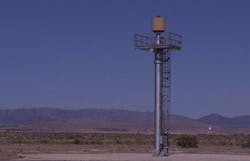SRCTec to build ground-based radars to enable UAVs to sense and avoid other aircraft
Officials of the Army Contracting Command at Redstone Arsenal, Ala., awarded a $7.2 million contract to SRCTec on Friday to provide the Ground Based Sense-And-Avoid Lightweight Surveillance And Target Acquisition Radar (GBSAA LSTAR).
The GBSAA radar system enables users to operate UAVs in the National Airspace System without a chase plane or ground observer. It uses the SRCTec Lightweight Surveillance And Target Acquisition Radar (LSTAR) ground sensors to detect airborne traffic and enable the UAV operator to maintain a safe distance between his UAV and other aircraft.
Related: Air Force surveys industry for companies able to design UAV common sense-and-avoid system
The Army Contracting Command awarded the contract to SRCTec on behalf of the The Product Directorate for Unmanned Systems Airspace Integration (USAIC) product directorate, which is part of the UAS Project Office within the Program Executive Office for Aviation at Redstone Arsenal in Huntsville, Ala.
The GBSAA LSTAR system is an alternate means to comply with the FAA see-and-avoid regulations and operates in bad weather and at night; provides an expanded operational area and increased operational time, SRCTec officials say.
By 2016 Army officials plan to install the GBSAA radar network at five installations to maintain separation of UAVs and civil aircraft. The five sites are Fort Hood, Texas; Fort Riley, Kan.; Fort Stewart, Ga.; Fort Campbell, Ken.; and Fort Drum, N.Y.
The SRCTec LSTAR family of air surveillance radars provides 360-degree, 3-D electronic scanning for detecting and tracking difficult airborne targets like UAVs.
The radars detect and track fixed-wing aircraft and helicopters such as ultralights, para-gliders, hang-gliders, and UAVs. These systems also are for border air surveillance, UAV sense and avoid, local airspace management, critical infrastructure protection, and wind farm applications, SRCTec officials say.
LSTAR systems are network ready using standard ASTERIX, DDS, or custom interfaces; can be used to cue thermal imaging cameras; offer remote and unattended operation; and are transportable for rapid and unobtrusive emplacement.
Related: Army to buy counter-mortar radars from SRCTec in potential quarter-billion-dollar contract
The LSTAR (V)2 is for applications with minimum infrastructure available, while the larger LSTAR (V)3 is for applications that require better performance where and slightly more infrastructure is available.
On this contract SRCTec will do the work in Syracuse, N.Y., and should be finished by October 2015. For more information contact SRCTec online at www.srcinc.com, or Redstone Arsenal at www.garrison.redstone.army.mil.
